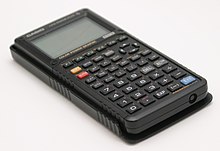Casio 9850
The Casio 9850 series (also called 9x50 ) is a series of scientific, graphic, programmable pocket calculators from the Casio brand from 1996 to 2008.
overview
First manufactured in 1996, there have been many variations of the CFX-9850G. The 9850 series models have three-color screens, with the exception of the 9750 versions, which come with black and white displays. The 9950G has 64 KiB of memory instead of the 32 KiB of the original 9850G. Later versions such as the GA, GB and GC models fixed some bugs in the original G models and provided some new statistics and financial features. The GB models have an integrated software library.
French versions
There are French versions where the fraction and exponent keys are labeled differently.
| Standard versions | French versions |
|---|---|
|
|
|
|
|
|
Weight and dimensions
The calculators weigh around 190 grams including batteries . The measures are:
| length | 176 mm |
| width | 83 mm |
| height | 19.7 mm |
Functions
The models in the series enable the calculation of scientific values and calculations, support infinitesimal calculus and the display of graphics. They enable the writing and execution of self-written programs and can operate with statistics and matrices .
Power consumption
The back of the device shows a slightly protruding battery compartment cover the compartment for four AAA alkaline batteries for the primary power supply and a CR2032 Lithium - battery cell for the memory backup, when the main power supply is interrupted. The device has a power consumption of 60 milliwatts and switches off automatically after about six minutes if the device is not used. The battery life for the primary power supply ranges between 240 hours and 150 hours. The lithium cells for the storage backup have a lifespan of approximately two years.
Display
The resolution of the display is 128 by 64 pixels (the first rows - vertical and horizontal - cannot be used for graphics). The display can show characters on 8 lines and 21 columns. The bottom line is reserved for displaying the functions of the six function keys (F1 – F6).
The screen can display the graphics in three colors: orange, blue and green. The only exception is the Casio FX-9750, which only has a black and white display.
The colors are divided into three levels: orange is about blue and blue is about green. This system allows graphics to be added or removed without changing the graphics underneath.
Storage spaces
The devices are supplied with either 32 or 64 KB memory, which is used for programs, statistics, matrices, lists, static and dynamic diagrams and the associated settings, functions, recursions , equations , financial data, and variables (which are used by all programs) can be used. These can be deleted individually or completely in the MEM menu.
Data exchange
The device can be connected to a computer (FA-122 interface unit and cable) or to another computer (SB-62 cable) using specialized cables in order to exchange data such as programs, equations, graphs, etc. You can also send data to a Casio label printer (SB-62 cable). The specified transmission speed is 9600 bytes per second.
The included link cable was designed and patented by Purple Computing. It was made by Traveling Software (AKA Laplink.com) and later by Purple Computing. The common name for the cable is “PC-Link”. It has a 2.5 mm stereo RCA plug on one end, the patented electronic circuitry inside the plastic cable and a DB9F (9-pin serial connector) on the other side to connect the PC via a serial interface . The circuit converts low voltage (low power signals of the pocket calculator) to be on the same level as a serial RS232 interface of a PC.
Program library
The CFX-9850GB PLUS and CFX-9950GB PLUS models have an integrated program library consisting of programs that can perform more complex calculations. Among other things, calculating with differential equations . The programs are divided into six branch libraries.
Graphics
Graphics can be drawn with a split screen display . Graphic areas can be shaded in configurable colors. The graphical viewport can be resized and moved (these settings can be saved for later recall), and points along the curve can be traced. Special tools can be used to find useful points such as extreme values (maximum and minimum x and y values , respectively ) and intersection points. The calculator also has a dedicated section for more complicated conic graphics. Dynamic graphics provide all of the functionality of regular graphics, but allow a variable in the graphics equation to be bound over a range of values.
Lists and tables
Up to 36 lists can be saved and manipulated in the list manager in various ways. The lists can also be used to insert data in integrated statistical operations, to create various statistical diagrams, to perform regression analysis and to generate graphs such as scatter plots and box and whisker plots . Tables of values can be created from functions, recursive series can be created and polynomial or general equations as well as linear equation systems can be solved.
Financial bills
There are also a number of financial operations, such as interest bills and depreciation, that the calculator can also calculate.
Web links
Individual evidence
- ↑ a b CFX-9850G - 9950G instruction manual . CASIO COMPUTER CO., LTD .. Retrieved October 6, 2016.
- ^ Roy FA Maclean: History of Casio Calculators . Archived from the original on May 30, 2016. Info: The archive link was inserted automatically and has not yet been checked. Please check the original and archive link according to the instructions and then remove this notice. Retrieved October 6, 2016.



